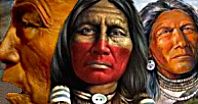|
|  |

HOHOKAM ANCIENT INDIAN CIVILIZATION

Predecessors of the Hohokam
AUTHOR: Linda M. Gregonis & Karl J. Reinhard
Centuries before Europeans first saw the Tucson Basin, a group of Indians with a distinctive way of life had settled there. Known today as the Hohokam (ho-ho-kam), these people built villages close to streams in order to farm the region's rich bottomlands. They lived in the basin from about A.D. 300 to 1500.
The Tucson Basin villagers were part of the larger Hohokam world, whose inhabitants lived in the Sonoran Desert of southern Arizona. They ably adapted themselves to the desert environment by farming along drainages and hunting and gathering in the desert and mountains.
The Hohokam were not the first to live in the Tucson Basin. During the Ice Age, people migrated from Siberia across the Bering Strait into Alaska. These "Paleo-Indians" followed herds of big game into North America.
By 9500 B.C., bands of hunters wandered into southern Arizona, where they found a desert grassland. Mammoths that thrived in the grassland were hunted by the Indians. Hunters trapped mammoths along streams and lakes and killed them with spears. The carcasses of the ponderous beasts were butchered on the spot and the meat was cooked nearby.
Although best known for their mammoth hunting, the Paleo-Indians ate other types of animals including bison. They also collected and ate plant foods.
As the climate warmed and dried after the end of the Ice Age, mammoths and associated animals such as horses and camels began to disappear from North America.
To the Indians, the change was gradual. They found fewer mammoths each year, so they supplemented their diet with a variety of plant foods and smaller game. Groups of Indians discovered the nutritive value of weed and grass seeds, ground to flour on flat rocks and made into gruels and breads.
The use of grinding slabs marks the beginning of the Desert Archaic tradition. In the Tucson area, the Desert Archaic tradition lasted from 7000 B.C. to about A.D. 300. During that time, small bands of people moved around the basin gathering plants. They lived primarily in the open, but probably also built temporary shelters.
Summer found them in the foothills, collecting foods such as cactus fruits and mesquite beans. Acorns, pine nuts, and other foods from the higher mountains were gathered in the fall. Although hunting took place the year-round it was especially important in the winter and spring months when plant foods were scarce. The Archaic people established camps at each collection point, to which they returned year after year.
Late in the Archaic Period, corn was introduced into the region from Mexico. People planted the crop near camps with permanent water sources. After planting, the hunter-gatherers moved on to gather wild foods, returning only to harvest the ripened crop. They treated the cultivated food as one more native plant to be gathered.
SOURCE:
Excerpted from the book, 'Hohokam Indians of the Tucson Basin' by Linda M. Gregonis & Karl J. Reinhard.
Copyright © 1979.The Arizona Board of Regents
RELATED ARTICLES:
The Hohokam Indians of the Tucson Basin
Agriculture of the Hohokam Indian
Hunting and Gathering Practices of the Hohokam
Clothing and footwear of the Hohokam
Discovery of Hohokam ruins surprises archaeologists
|
 |


|
|
| | | | | | | | |
 |
|
|

